Head of Medusa
This week: The Head of Medusa; Let pruning commence; The problem with grafts; Plastic repairs; Flowering plants; Happy Birthday!;

Here comes the sun!
Compared to the first week of January last year, the difference could not be more stark. On New Year’s Day 2020, I was walking up the dry stream bed in the village, enjoying bright, warm sunshine.
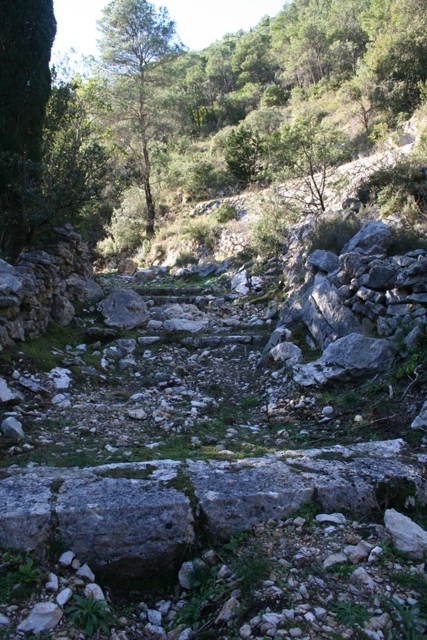
On New Years Day this year, I was ensconced inside, waiting for the rain to stop.
Of the first 10 days in January, we have had rain on all 10 of them.
It was only on Tuesday this week that the sky was cloudless and the sun shone. I had my first wander through the Maquis up to St. Michael’s Church late in the afternoon. I was in the shade and wrapped up well. However it was nice to get out in the fresh air.
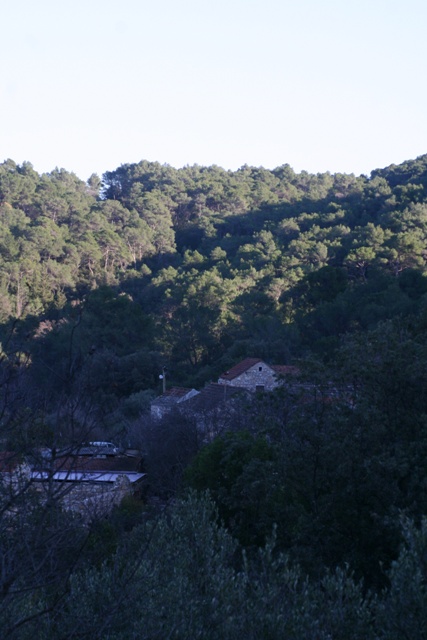
Little has changed over the winter and since my last foray up the ancient donkey track.
There is no obvious damage to the ancient walls caused by the Wild Boar rooting amongst the stones for food. On the island we have many Boar living in the Maquis.
On the ground there were large quantities of Acorns, which the Boar feed on.
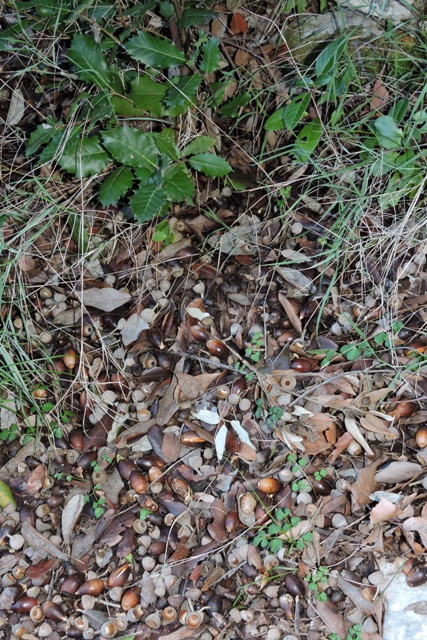
So perhaps the winter Boar hunts which have been taking place have either thinned the numbers or driven them deeper into the uninhabited areas of the island.
The first snow of winter is on the top of the Dinaric Alps. It does always look nice from this distance (70+ km). However I am pleased Dol is in an almost snow and frost free climate zone.
One evening this week, just at the point of sunset, there was falling snow over the island of Brač. The setting sun illuminated the roiling mass of snowflakes in shades of pink and purple.
But as the flakes passed through warmer, lower air layers, what touched the ground was just a cold rain.
The clear days and even clearer nights of this week have meant that the temperature recorded on my weather station had dipped to 0ºC just before dawn on one morning.
But the good news is that days are getting noticeably longer, especially in the evening.
This next week it will be cold for a couple of days and then the weather starts to warm up. In this video, everything blue is cold. The arrows show the direction of the wind.
The Head of Medusa
I am sure you can remember from your Greek Mythology lessons that Medusa was the Gorgon with serpents for hair. Even after being slain by Perseus, if you looked directly at her, you would be turned to stone.
In case you have forgotten, Medusa was one of the three Gorgons, daughters of Phorcys and Ceto, sisters of the Graeae, Echidna, and Ladon.
All three are described as being dreadful and fearsome beasts. Medusa alone was a beautiful mortal to begin with.
Medusa was the exception in the family, until she incurred the wrath of Athena. In the legends this is either due to her boastfulness or because of an ill-fated love affair with Poseidon.
She was transformed into a vicious monster with snakes for hair. Medusa was killed by Perseus, who afterward used her still potent head as a weapon, before gifting it to Athena.
Deep in the orchard, next to the compost heap and near to the wood shed I have a pile of wooden “heads”, stored under a plastic sheet to keep them dry.
They have been there for two or three years, since a neighbour cut down some trees and gave me the root bowls to burn in the wood stove.
There are about 15 of them, so this week I brought a couple out, ready to cut to a size that I can get through the wood stove door.
As I put one on the concrete before applying the chain saw, with the roots facing up, what came to mind was the image of Medusa from Greek mythology.
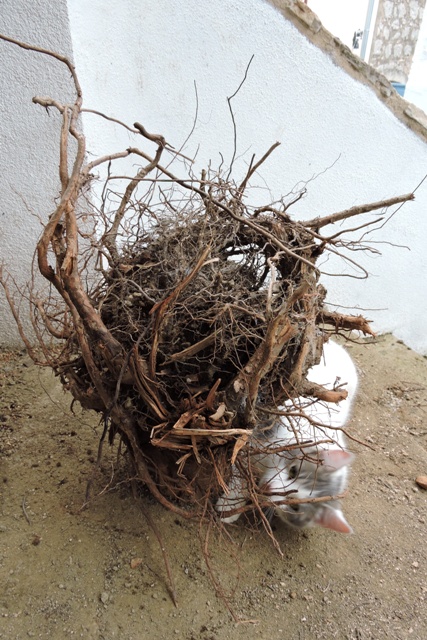
They are a species of pine, but the problem is the clay soil which surrounds the root ball. Because they have been left to dry, the clay will powder quite easily but it makes a terrible mess.
For this reason I am cutting on concrete rather than where I usually cut timber which is on sand. The clay is a lot easier to sweep up on concrete.
I should add that I’m not so desperate for wood that I need to cut these pieces up.
Rather, this is a job I’ve been going to do for a while and now seems like a good time to do it.
Chiefly, this is because we have had so much rain recently. The ground is sodden and I don’t want to walk on the orchard’s soils and compress them when working.
Just cutting one or two heads a day, means that I will be able to clear the pile so I can use the storage area for something else.
I already have a plentiful supply of wood for the fire, but I can work under cover whilst removing the dry clay on these heads and trimming them to size too.
Let pruning commence
Pruning is not one of my favourite jobs in the garden. Mostly this is because it is mainly done in winter, when the drupe orchard gets little sun – and that is when we actually have sunny days.
But this week I made a start. It’s not only the apples, pears, plums and apricots which need to be pruned though, there are the shrubs too.
One easy morning’s work was to clear the bed outside the kitchen window. In here there are Canna Indica and an Aspidistra.
I thought the Aspidistras would probably die when I transplanted them. Instead they seem to be thriving.
There are also some Hyacinth bulbs, Canna lilies and a Lantana.
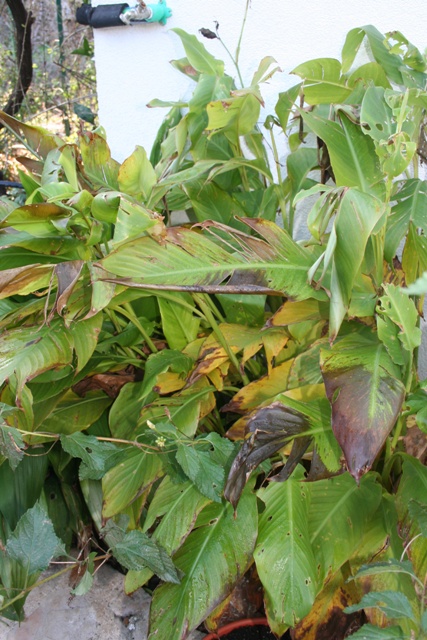
Because of the location of the bed, it is exposed exposed to southern sun throughout the year. Without deep soils, the plants need to be hardy.
Aspidistras, which are house plants in cold northern latitudes are also known as Cast Iron plants, because they are nature’s survivors.
Boy is mine surviving!
Although the bed get some moisture from where the irrigation pipe is connected to the tap, that is about all it gets.
The Lantana is another survivor, but this winter, being fed up of it’s trailing habit, I have cut it well back by ⅔ . Afterwards I installed a framework of hooks on the wall, so that it will become more of a fan trained shrub.
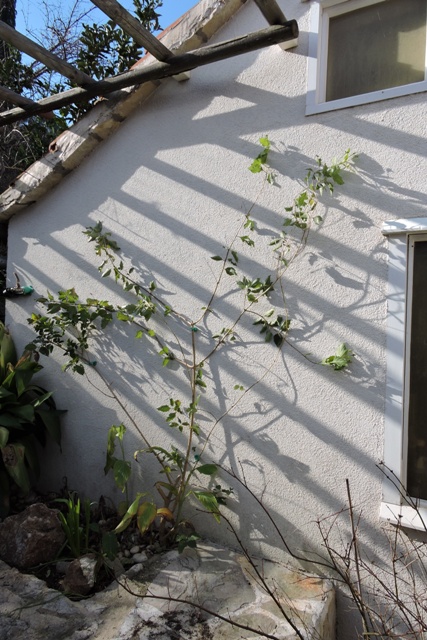
The Lantana is the pink flowered variety, which is very attractive to butterflies.
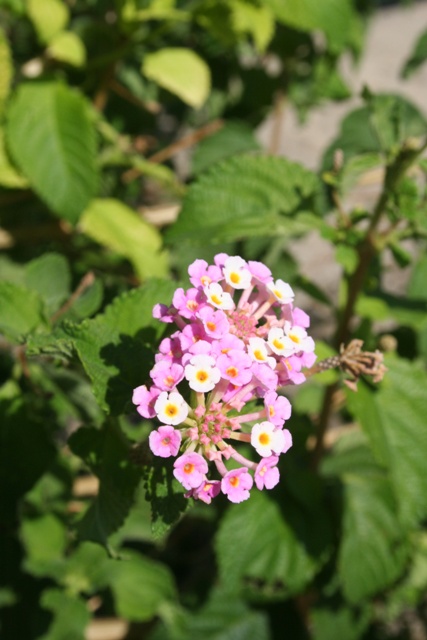
These Mediterranean plants attracts butterflies and moths throughout their long flowering season.
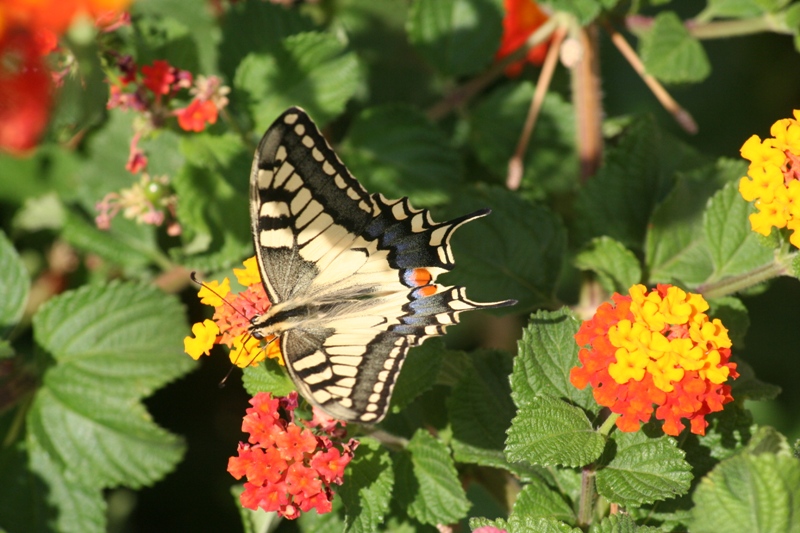
Another shrub which desperately needs a haircut is my white flowered Budleija.
In 2020 it had it’s best flowering season since I planted it, so I want to just take it back a bit. My pruning books says to wait until late winter when the plant is starting into growth.
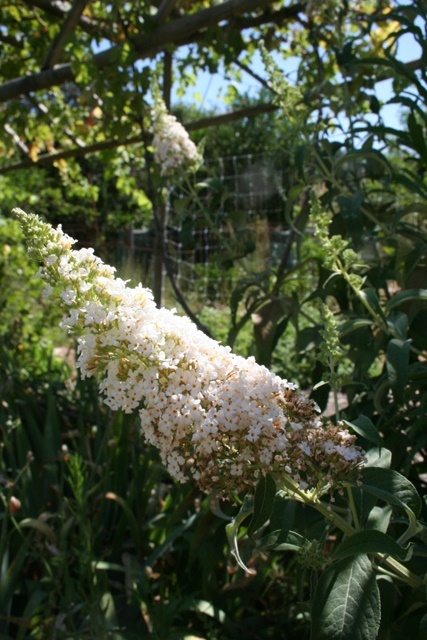
Well here in Dol, it has never stopped growing!
The problem with grafts
The Grafting of plants by horticulturalists has been going on for some 4,000 years. Chinese texts from the 6th century BC refer to grafting pears, persimmon and jujube trees.
I have all three species in my orchards.
Grafting began because when you plants seeds, they do not grow true to the original. They can of course be better, but they can also be worse. Grafted plants grow true to the parent.
So the first orchards comprised of species that could be easily grown from cuttings. Trees like figs and also those which could be grown from root suckers, like pomegranate.
The Greeks, Romans and people of the Middle East all practised and wrote about the art of grafting. Early writers describe how the technique is used to improve their fruiting trees.
There are shelves full of books that have been written on the subject and in the 21st century more is known and understood about grafting and its stable mate, budding, than ever before.
All the very old trees in my orchards – plums and apples – are ungrafted. Almost every fruit tree I have planted is a graft.
But therein lies a problem.
Modern grafting takes a known root stock, perhaps a dwarfing root stock, and then joins a known fruiting variety onto the roots.
The union where the graft has been made is often a visible swelling just above soil level.
The two parts which are joined grow at different rates and so you can get a lot of suckers appearing from below the graft union, where the roots are vigorous.
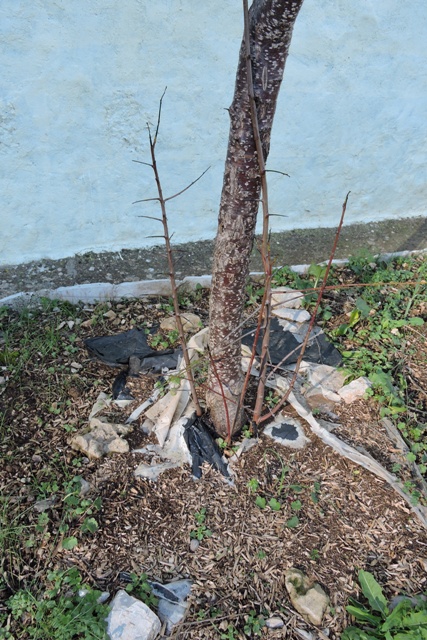
This has happened over the past 12 months to both of my Apricot trees in the Drupe orchard.

On one tree, a veritable thicket of suckers and water shoots has appeared. The shoots will take away nutrients and vigour from the grafted fruit tree.
These shoots if left will not just look unsightly, but will prevent the grafted part of the tree producing fruit.
They have to be removed in the correct way though.
They need cutting off as close as possible to the main stem of the tree. If any bud material is left behind, another sucker will just grow to replace the one removed.
The wounds that are left needs painting with a sealing compound to prevent diseases getting in and especially with citrus trees, where the shoots have fearsome spines, they needs handling carefully once removed.
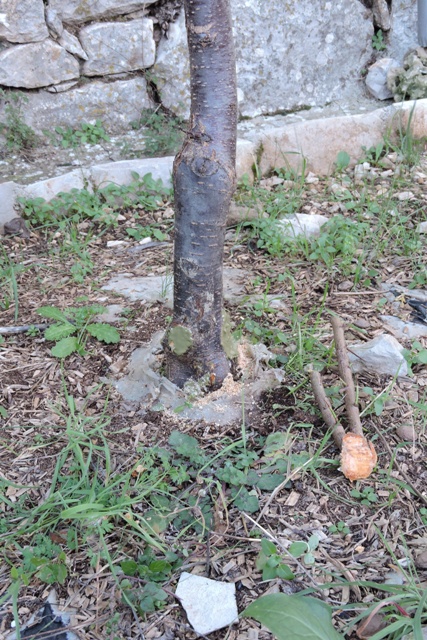
I used a Stanley knife with a new, sterile blade to remove the thin suckers. But I needed to get a specialist pruning saw for the thickest shoots.
All my prunings will go through the big mulching machine. But thick gloves are called for when dealing with the pruning, to prevent hand injuries because even these Apricot suckers have sharp spines.
Plastic repairs
I’ve watched Gizmo several times now, on my new plastic roof, with claws extended, padding the small puddles of rain water that have accumulated between the support beams.
I think he is unsettled because the roof is an almost clear polythene sheet and the water is acting as a lens, so he can see movement underneath. His reaction is to probe the water pool and of course his razer sharp claws are piercing the plastic.
This week, as the rain stopped, so his pawing has stopped. He is just going to sleep on the plastic, in the sunshine instead…
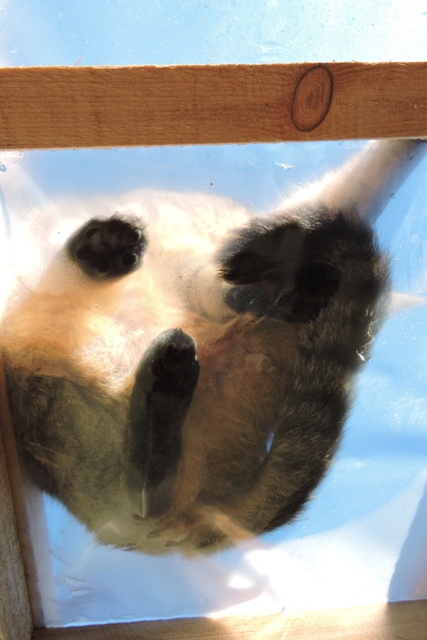
It has given me the opportunity to patch some of the larger holes. Or at least the holes that were letting the biggest drips through.
Polythene is strange stuff, so my repairs are experimental. I’ll see if they have been successful the next time it rains.
I have used some plastic cyanoacetate “superglue” as the adhesive.
I started by running some sand paper over a square of the material I had cut when I was installing the plastic sheeting. This roughens the surface, giving the glue something to ‘key’ onto.
The last time it rained, I drew circles round the holes with a spirit marker, so I had an ideas of what needed patching.
Using the ladder to access the top of the frame, I roughened the areas around each circle and then cut some circular patches of the right size.
The cyanoacetate glue spread easily on each polythene patch, which was then pressed onto the corresponding area of the roof.

I needed to smooth out air bubbles and even though the sun was shining, it still took several minutes for the glue to set.
This makes me wonder if my attempt has been successful. Superglue is usually an ‘instant’ adhesive, but as I said at the start, plastic is funny stuff to repair.
I’m hoping that by patching both top and bottom, it should have repaired the material. If not, I will have to try a different adhesive.
Flowering plants
Even in the middle of winter I have plants in flower in the greenhouse.
My favourite is the Strelitzia regina, the Bird of Paradise plant. This lives outside all summer and I brought it in because I think it gets just a little too cold here for it to stay outside all year.
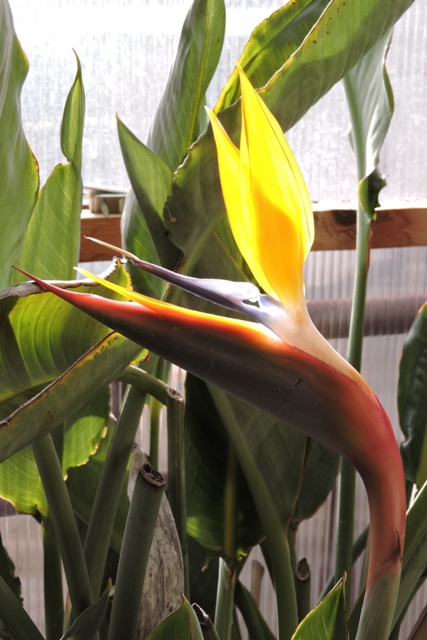
I have two flowers at the moment, which when backlit by the low sun, look magnificent.
Another plant I have which is in flower is a bulb, but I am not sure what variety it is.

It looks like a Hippeastrum lily of some kind and it has a very large bulb, some 12 cm in diameter.
I suspect it has come from South America but with 90 species and 600 cultivars, I’m not sure where to start looking. Unfortunately I inherited it without any name label.
Even so, it seems to enjoy its position on the greenhouse shelf.
Happy Birthday!
What do a minimum of 280,000 people do every day of the year?
Answer: they edit a Wickipedia article.
Wickipedia is celebrating it’s 20th Birthday this week. The first article appeared on 15th January 2000.
This week, I have included eight links to Wikipedia articles about something I have mentioned in the blog. If you click on a link, it will open in a new tab in your browser, so you will not loose your place in the blog.
I am one of the millions of registered editors and I tend to correct police history pages, where because of a lack of on line reference material for this specialist subject, there are sometimes errors in dates.
There are criticisms about Wikipedia, particularly that it does not have the academic rigour of a printed encyclopaedia. However bearing in mind that all the article authors are volunteers, there are bound to be some errors. In general I find the articles informative and I can always go much deeper into the subject by following the various links.
So thank you Jimmy Wales, the inventor and CEO of Wikipedia, and here’s to the next 20 years. NCG
2 Responses
John Bailey
Your climate is much warmer than ours as you know . Looking outside we have a covering of snow. Certainly not gardening weather.
Mike
Wikipedia is not all its cracked up to be. Some sections are captured and locked by people with a political agenda. I never trust it now.